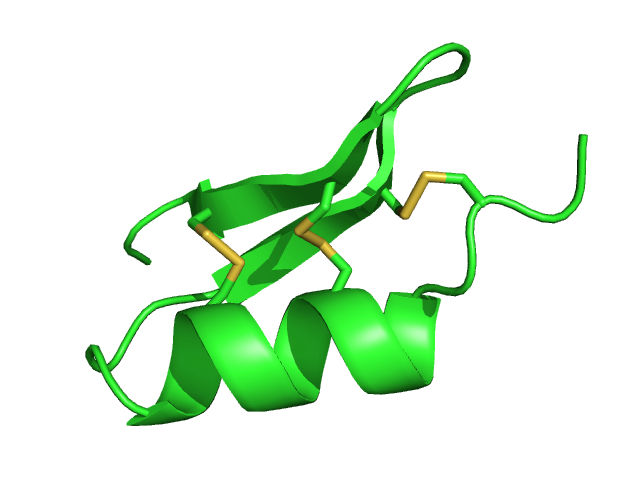scyllatoxin on:
[Wikipedia]
[Google]
[Amazon]
Scyllatoxin (also leiurotoxin I) is a 
toxin
A toxin is a naturally occurring poison produced by metabolic activities of living cells or organisms. They occur especially as proteins, often conjugated. The term was first used by organic chemist Ludwig Brieger (1849ŌĆō1919), derived ...
, from the scorpion
Scorpions are predatory arachnids of the Order (biology), order Scorpiones. They have eight legs and are easily recognized by a pair of Chela (organ), grasping pincers and a narrow, segmented tail, often carried in a characteristic forward cur ...
'' Leiurus quinquestriatus hebraeus'', which blocks small-conductance Ca2+-activated K+ channels. It is named after Scylla, a sea monster from Greek mythology
Greek mythology is the body of myths originally told by the Ancient Greece, ancient Greeks, and a genre of ancient Greek folklore, today absorbed alongside Roman mythology into the broader designation of classical mythology. These stories conc ...
. Charybdotoxin is also found in the venom from the same species of scorpion, and is named after the sea monster Charybdis. In Greek mythology, Scylla and Charybdis lived on rocks on opposing sides of a narrow strait of water.

Sources
Scyllatoxin is one of the components of thevenom
Venom or zootoxin is a type of toxin produced by an animal that is actively delivered through a wound by means of a bite, sting, or similar action. The toxin is delivered through a specially evolved ''venom apparatus'', such as fangs or a sti ...
of the Israeli scorpion
Scorpions are predatory arachnids of the Order (biology), order Scorpiones. They have eight legs and are easily recognized by a pair of Chela (organ), grasping pincers and a narrow, segmented tail, often carried in a characteristic forward cur ...
''ŌĆśLeiurus quinquestriatus hebraeusŌĆÖ''. It consists of only 0.02% of the total protein in crude venom.
Chemistry
Leiurotoxin I is a 31-residue peptide (sequence AFCNLRMCQLSCRSLGLLGKCIGDKCECVKH-NH2), with ahelix
A helix (; ) is a shape like a cylindrical coil spring or the thread of a machine screw. It is a type of smooth space curve with tangent lines at a constant angle to a fixed axis. Helices are important in biology, as the DNA molecule is for ...
and a short antiparallel ╬▓-sheet
The beta sheet (╬▓-sheet, also ╬▓-pleated sheet) is a common structural motif, motif of the regular protein secondary structure. Beta sheets consist of beta strands (╬▓-strands) connected laterally by at least two or three backbone chain, backbon ...
. This toxin is stabilized by disulfide bonds
In chemistry, a disulfide (or disulphide in British English) is a compound containing a functional group or the anion. The linkage is also called an SS-bond or sometimes a disulfide bridge and usually derived from two thiol groups.
In in ...
: Cys8-Cys26 and Cys12-Cys28 is bound to the β-sheet, while Cys3-Cys21 is bound to an N-terminal segment preceding the helix. Leiurotoxin adopts the ά/β motif. Especially the positively charged residues (Arg6 and Arg13, which are located in the ά helix) are important for the expression of toxin biological activities and for its receptor affinity.
Target
Scyllatoxin is a blocker of small-conductance Ca2+ŌĆō activated K+ channels at 10ŌłÆ13ŌĆō10ŌłÆ11 M concentrations in various cell types. This toxin shows similarity in its physiological activity and binding specificity to apamin, but both toxins show no structural similarity.Mode of action
Scyllatoxin blocks the slow after- hyperpolarization that follows anaction potential
An action potential (also known as a nerve impulse or "spike" when in a neuron) is a series of quick changes in voltage across a cell membrane. An action potential occurs when the membrane potential of a specific Cell (biology), cell rapidly ri ...
in some nerve cells
A neuron (American English), neurone (British English), or nerve cell, is an excitable cell that fires electric signals called action potentials across a neural network in the nervous system. They are located in the nervous system and help to ...
.
Toxicity
Scyllatoxin induces spontaneous contractions inguinea pig
The guinea pig or domestic guinea pig (''Cavia porcellus''), also known as the cavy or domestic cavy ( ), is a species of rodent belonging to the genus ''Cavia'', family Caviidae. Animal fancy, Breeders tend to use the name "cavy" for the ani ...
taenia coli muscle cells that have
been relaxed with epinephrine.
References
{{Toxins Neurotoxins Ion channel toxins Scorpion toxins